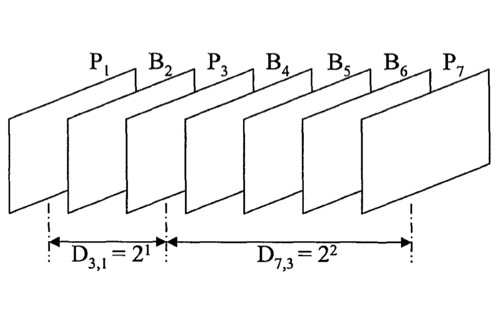Apple has been granted a patent (number 7903730) by the US Patent & Trademark Office for a method and apparatus for variable accuracy inter-picture timing specification for digital video encoding. It relates to the field of multimedia compression systems. In particular the present invention discloses methods and systems for specifying variable accuracy inter-picture timing.
Specifically, the present invention discloses a system that allows the relative timing of nearby video pictures to be encoded in a very efficient manner. In one embodiment, the display time difference between a current video picture and a nearby video picture is determined. The display time difference is then encoded into a digital representation of the video picture. In a preferred embodiment, the nearby video picture is the most recently transmitted stored picture. For coding efficiency, the display time difference may be encoded using a variable length coding system or arithmetic coding. In an alternate embodiment, the display time difference is encoded as a power of two to reduce the number of bits transmitted. The inventors are Barin Geoffry Haskell, David William Stinger, Andriana Dumitras and Atul Puri.
Here’s Apple’s background and summary of the invention: “Digital based electronic media formats are finally on the cusp of largely replacing analog electronic media formats. Digital compact discs (CDs) replaced analog vinyl records long ago. Analog magnetic cassette tapes are becoming increasingly rare. Second and third generation digital audio systems such as Mini-discs and MP3 (MPEG Audio-layer 3) are now taking market share from the first generation digital audio format of compact discs.
“The video media has been slower to move to digital storage and transmission formats than audio. This has been largely due to the massive amounts of digital information required to accurately represent video in digital form. The massive amounts of digital information needed to accurately represent video require very high-capacity digital storage systems and high-bandwidth transmission systems.
“However, video is now rapidly moving to digital storage and transmission formats. Faster computer processors, high-density storage systems, and new efficient compression and encoding algorithms have finally made digital video practical at consumer price points. The DVD (Digital Versatile Disc), a digital video system, has been one of the fastest selling consumer electronic products in years. DVDs have been rapidly supplanting Video-Cassette Recorders (VCRs) as the pre-recorded video playback system of choice due to their high video quality, very high audio quality, convenience, and extra features. The antiquated analog NTSC (National Television Standards Committee) video transmission system is currently in the process of being replaced with the digital ATSC (Advanced Television Standards Committee) video transmission system.
“Computer systems have been using various different digital video encoding formats for a number of years. Among the best digital video compression and encoding systems used by computer systems have been the digital video systems backed by the Motion Pictures Expert Group commonly known by the acronym MPEG. The three most well known and highly used digital video formats from MPEG are known simply as MPEG-1, MPEG-2, and MPEG-4. VideoCDs (VCDs) and early consumer-grade digital video editing systems use the early MPEG-1 digital video encoding format. Digital Versatile Discs (DVDs) and the Dish Network brand Direct Broadcast Satellite (DBS) television broadcast system use the higher quality MPEG-2 digital video compression and encoding system. The MPEG-4 encoding system is rapidly being adapted by the latest computer based digital video encoders and associated digital video players.
“The MPEG-2 and MPEG-4 standards compress a series of video frames or video fields and then encode the compressed frames or fields into a digital bitstream. When encoding a video frame or field with the MPEG-2 and MPEG-4 systems, the video frame or field is divided into a rectangular grid of macroblocks. Each macroblock is independently compressed and encoded.
“When compressing a video frame or field, the MPEG-4 standard may compress the frame or field into one of three types of compressed frames or fields: Intra-frames (I-frames), Unidirectional Predicted frames (P-frames), or Bi-Directional Predicted frames (B-frames). Intra-frames completely independently encode an independent video frame with no reference to other video frames. P-frames define a video frame with reference to a single previously displayed video frame. B-frames define a video frame with reference to both a video frame displayed before the current frame and a video frame to be displayed after the current frame. Due to their efficient usage of redundant video information, P-frames and B-frames generally provide the best compression.
“A method and apparatus for variable accuracy inter-picture timing specification for digital video encoding is disclosed. Specifically, the present invention discloses a system that allows the relative timing of nearby video pictures to be encoded in a very efficient manner. In one embodiment, the display time difference between a current video picture and a nearby video picture is determined. The display time difference is then encoded into a digital representation of the video picture. In a preferred embodiment, the nearby video picture is the most recently transmitted stored picture.
“For coding efficiency, the display time difference may be encoded using a variable length coding system or arithmetic coding. In an alternate embodiment, the display time difference is encoded as a power of two to reduce the number of bits transmitted.”
— Dennis Sellers

